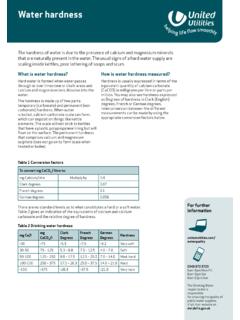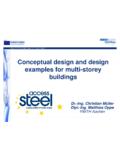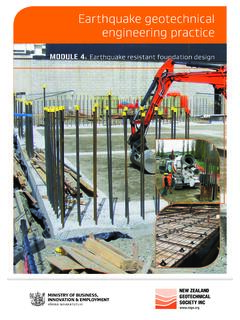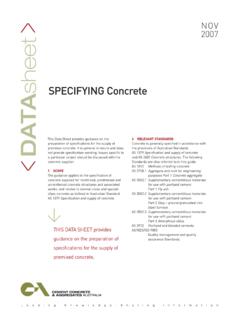Transcription of Site sewer construction guide - United Utilities
1 United Utilities site sewer construction guide 1 site sewer construction guide2 United Utilities site sewer construction GuideUnited Utilities site sewer construction guide 3 SAFETY IN SEWERSThe Health and Safety of workers on the Public sewer Network is our number one priority. All work on public sewerage apparatus must be agreed in writing by United Utilities (see page 26 for further details). As a minimum requirement, workers carrying out sewer construction on the public sewer must hold a current City and Guilds or SQA standard or CABWI Level 2 Award Certificate for Working in Medium or High Risk Confined Spaces in the Water Industry. In addition, those carrying out the work must be suitably excavation works should be carried out in a safe manner taking into account: underground services and structures confined space working ground conditions and collapses preventing falls safe access and egressREMEMBER: Access to the public sewer network must be agreed in writing.
2 You must Log On before starting work and Log Off the sewer network by telephoning 0782 653 94 59 and quoting the unique Access Certificate or sewer Connection reference are expensive to construct and if not built correctly, remedial works can be disruptive, time consuming, costly and in some circumstances, have adverse effects on a company s reputation. In many instances, a lot of mistakes can be avoided by considering the specification and requirements before and during document has been produced as an on- site guide for contractors and operatives constructing sewers, with advice notes provided to avoid some of the common on site agreement drawings and manufacturer s recommendations should be adhered to. Should this not be practicable, design changes or amendments must be agreed with United Utilities before is a contractor s responsibility to ensure that all operatives are competent and experienced to complete works to the required this booklet with you on site as a quick reference guideIntroduction3 Introduction4 Safety in sewers and excavations4 Trenches and excavations4 Control of site and trench groundwater5 Agreed drawings5 construction materials5 Storage of materials6 Manhole chambers6 Typical manhole chambers up to 3m deep6 Sizing of manhole chamber6 Manhole base and channel construction7 Channels8 Lateral connection manhole channels8 Manhole benching9 Stub and rocker pipes9 Setting out position of 1st ring and cover slab10 Manhole rings.
3 Step irons 10 Ladders11 Cover slabs and access openings12 Positioning of cover slabs13 Adjusting brickwork, raising pieces and manhole cover and frames13 English Bond adjusting brickwork14 Manhole cover and frames15 Pipes and bedding15 sewer pipes and bedding specification15 Handling and storage of pipes15 Protection of sewers15 Pipe Bedding15 Recycled pipe bedding materials16 Laying and jointing of pipes16 Backfilling17 Testing of sewers17 Air testing17 Water testing17 CCTV surveys18 Connections18 Connections to existing public sewers18 Connections to existing public sewer manholes19 New manholes on existing public sewers20 Pre-formed junction connections20 Core-drilled saddle connections20 Back drop connections21 Access21 Bespoke or manhole chambers for storage systems22 Alternative access arrangements for larger diameter surface water sewer
4 Manholes23 Typical surface water flow control manhole24 Fixings and rails24 Metal fixings and chains24 Safety chains24 Hand rail and balustrades25 Other information25 Typical 1:20 manhole details26 Other contact information and adviceVersion October 2015 EXOnly Intrinsically Safe CCTV equipment can be used in public sewers4 United Utilities site sewer construction GuideUnited Utilities site sewer construction guide 5 Trenches and excavationsTrenches must be adequately supported, free from boulders and tree roots must be taken out. Muddy ground , water and soft areas in the trench base must be removed. Materials, spoil and equipment must be stored safely and plant should be operated within a safe working distance. The trench must be adequately protected from slips, trips, falls, site traffic and have a safe means of access and egress.
5 Trenches should be adequately dewatered to provide a firm base but not dug wider than necessary as excessive loading may be placed on the pipe. Should ground conditions be unsuitable for pipe laying and manhole construction , please consult with your engineer to design a of site and trench groundwaterThe discharge of site ground water and excavation dewatering to the public sewer is only permitted by approval from United Utilities in writing. In addition, care must be taken to prevent site debris, sludge or silt from entering the sewer network which could ultimately cause flow restrictions, blockages, flooding, pollution and also affect the receiving wastewater treatment works. Costs associated with such incidents may be recovered from those responsible.
6 In addition, should an inappropriate discharge of site groundwater or construction material cause a pollution incident, this may lead to prosecution. Safety in sewers and excavationsSafety in sewers and excavationsAgreed drawingsFor sewer adoption and diversion works, construction must comply with the drawings agreed by United Utilities . Similarly for public sewer connections, works must comply with the details which have been agreed by the Local Authority, the relevant Building Control Authority and the approval given by United Utilities for the works to is recommended that a site copy of the agreed drawings are available to those carrying out construction to avoid any mistakes or deviation from deviation from the agreed drawings must be agreed with United Utilities before materialsAll materials including pipes must comply with the United Utilities agreed drawings to Water Industry Standards (WIS) and be Kitemarked or have a similar EU certification mark.
7 Should it be necessary to change to an alternative product or material, this must be agreed in advance with United Utilities , before construction note when ordering, suppliers should be made aware that the products selected must comply with United Utilities Standard Details and the current edition of Sewers for Adoption not let site water enter the sewer to public sewer only permitted by approval from United Utilities in writingStorage of materialsAll materials should be handled with care and stored safely in accordance with manufacture s recommendations. 6 United Utilities site sewer construction GuideUnited Utilities site sewer construction guide 7 Channel typesChannel inverts must be constructed using channel fittings for pipe diameters up to 300mm.
8 Clay and suitably fixed plastic channels are acceptable. Granolithic channels formed for smaller diameter channels often are either not sufficiently finished or the profile of the channel is not maintained, causing the accumulation of solids and associated odour complaints and as such are not acceptable. Granolithic channels above 300mm diameter must be finished with a steel plastic bases constructed within manhole rings are also not permitted. Preformed concrete and plastic coated concrete bases are manhole chambers up to 3m deep Manholes should be constructed where there is a change of direction and/or a change of gradient, or where access is required for maintenance purposes. Such changes in direction or gradient must be made within the channel and not outside of the manhole or concealed by should also be positioned away from curb lines, preferably with the manhole cover positioned away from the wheel line of of manhole chamberManhole bases should be sized to accommodate the main channel, lateral connection channels and provide a minimum 600 x 600mm square landing area beneath the step rungs or ladder for main channels up to 375mm.
9 However, should there be several channels, the size of the chamber may need increased. Please note, road cambers should be considered when positioning manholes with double covers across the centre of a carriageway. Manhole base and channel constructionThe manhole base should be a minimum of 225mm deep to the barrel of the channel. To prevent the ingress of ground water and associated calcified deposits bleeding through the benching, the concrete should not be a dry mix and sufficiently compacted or pokered to remove voids and entrained air. Channels must be steep sided to at least the crown of the PIPESTUB PIPEM anhole chambersChannelsThe pipe joint adjacent to the channel should be a minimum of 100mm from the internal face of the manhole. Lateral connections into the manhole must also enter the chamber as channels, again at 100mm from the internal face of the chamber and connect to the main channel at soffit to soffit level, swept with the direction of main chambersRemember 600 x 600mm square landing area must be provided below the lowest step or ladder rung for sewers up to 375mm plastic inspection chamber bases must not be installed within manhole rings or brickwork length of channelChamber diameter X min1200950150010501800115021001300240014 502700155030001700 Benching should be self-cleansing and formed with high strength granolithic screed at a gradient of between 1:10 1:30.
10 Steep sided channel to pipe crown or 225mm concrete base, with 75mm blinding. UU Type 4 manhole deep8 United Utilities site sewer construction GuideUnited Utilities site sewer construction guide 9 Lateral connection manhole channelsLateral connections within manholes must meet the main channel at soffit to soffit level with the channel commencing 100mm from the chamber lateral channels must meet the main channel, swept in the direction of the main benchingBenching should be self-cleansing and formed with high strength concrete at a gradient of between 1:10 1:30. To maintain a smooth flow within the main channel, the benching must be formed vertically from the edge of the channel to at least the crown of the and rocker pipesThe manhole stub pipe must terminate within 150mm from the external face of the manhole.








